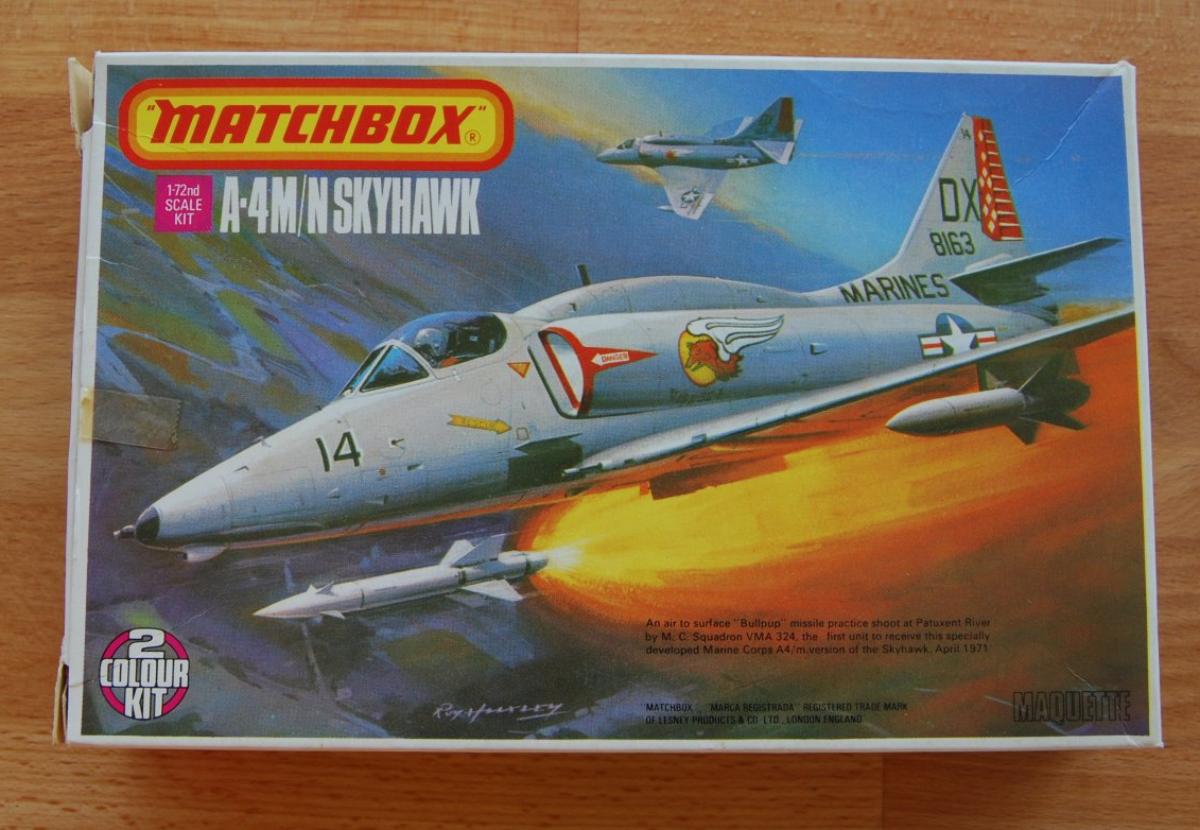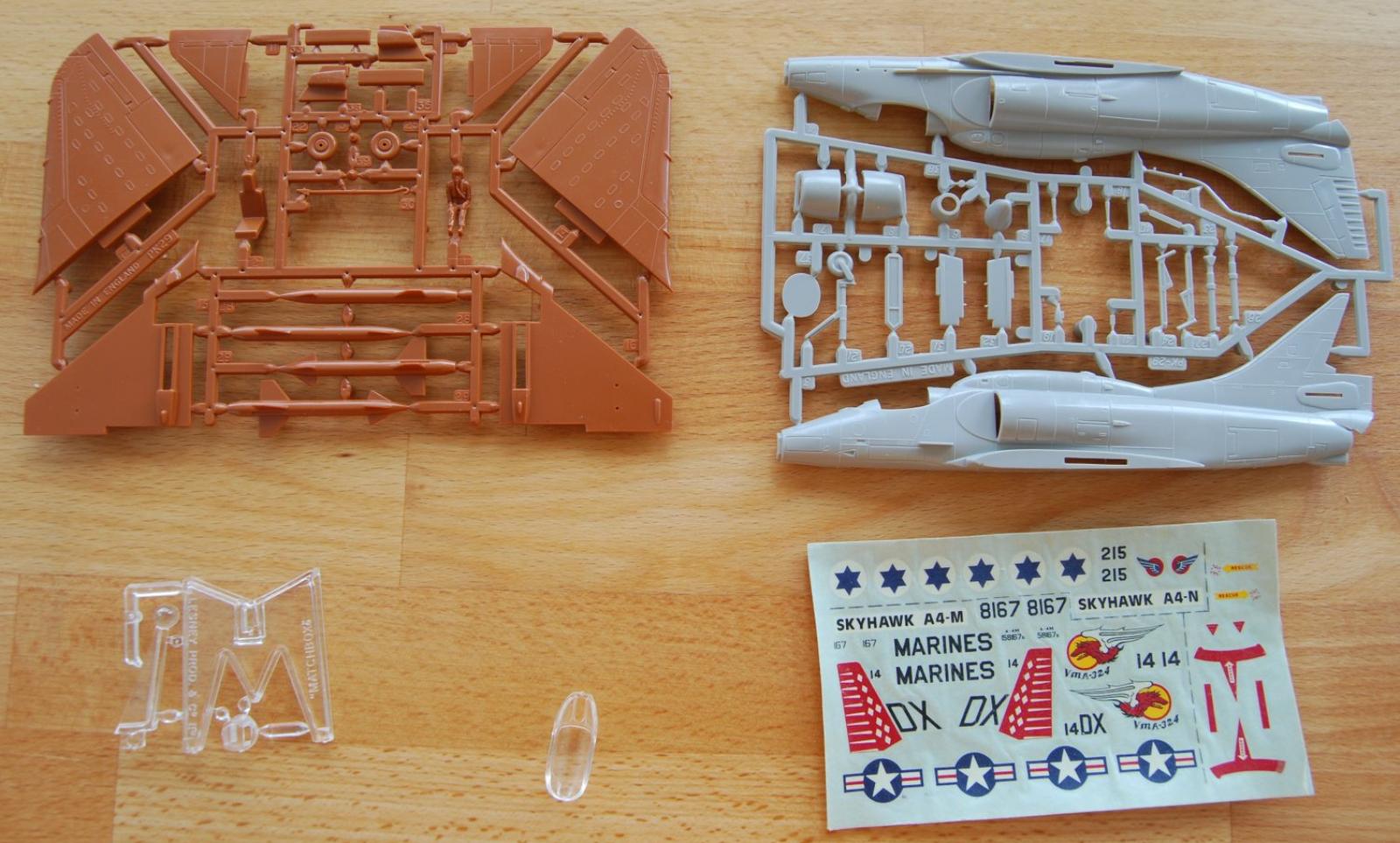Manufacturer: Matchbox
Scale: 1/72
Additional parts: none
Model build: Aug - Sep 2013

Manufacturer: Matchbox
Scale: 1/72
Additional parts: none
Model build: Aug - Sep 2013
Major Hans Kessler gripped the worn leather of his A-4's control stick. "Die Fliegende Zigarre" (The Flying Cigar) vibrated beneath him, a familiar thrumming that had been his constant companion for over a decade. Today, though, the vibration felt different – a tremor tinged with finality. This was it. The last flight of the A-4 Skyhawk in the Bundeswehr.
A bittersweet nostalgia washed over him. He'd flown this bird since they first arrived in Germany, sleek and new, replacing the lumbering Seahawks. He'd seen them serve on the Graf Zeppelin, skimming the waves like dragonflies. He'd been with them when they transitioned to land-based duty, the roar of their engines echoing through the Bavarian countryside.
Taxiing down the runway for the final time, Kessler stole a glance at the other two remaining A-4s. They were adorned with farewell markings, a skull and crossbones on a black and white checkered background, a morbid yet strangely fitting tribute to their long service.
Taking off, Kessler led the small formation into a clear blue sky. Below, the sprawling landscape of Bavaria unfolded – villages nestled in valleys, rivers snaking like silver ribbons. A pang of sadness hit him. These were the skies he'd patrolled for so many years, skies he wouldn't patrol anymore.
The radio crackled with the voice of his copilot, Lieutenant Meyer. "Major, emotional day, eh?"
Kessler chuckled, a dry rasp in his throat. "You could say that, Franz. You could say that."
They flew in comfortable silence for a while, the only sound the whine of the jets and the rhythmic whoosh of the wind. Then, air traffic control crackled to life, their voice laced with a hint of ceremony. "Skyraiders, this is Munich Approach. Cleared for a low-altitude flyover of the base. Enjoy your retirement."
A slow smile spread across Kessler's face. A low-altitude flyover. A pilot's dream, a chance to show off, to feel the raw power of the machine thrumming beneath him. He glanced at Meyer, who grinned back, eyes sparkling with anticipation.
With a flick of the switch, Kessler pushed the A-4 into a shallow dive. The familiar G-force pressed him into his seat, the world blurring into a canvas of greens and browns. He weaved through the valleys, skimmed the treetops, the A-4 screaming in protest at being pushed to its limits one last time.
As they approached the base, a collective gasp rose from the crowd gathered below. The old Skyhawks roared overhead in a tight formation, a final farewell dance. A cheer erupted, a mixture of awe and respect for the men and machines that had served their country with distinction.
Pulling out of the dive, Kessler leveled off, his heart pounding with a mixture of exhilaration and melancholy. They banked one last time in salute, the setting sun glinting off the aging airframes, before lining up for their final landing.
As the wheels touched down, a wave of emotion washed over Kessler. He'd closed the chapter on an era. The A-4s taxied to a designated spot, where they would be decommissioned, eventually finding their way to museums or perhaps foreign air forces.
Climbing out of the cockpit for the last time, Kessler ran a hand over the A-4's fuselage, a silent goodbye to his old friend. "Danke, alter Kamerad," he murmured. Thank you, old comrade. You may be grounded, but your legend will take flight in the stories we tell.

In the mid-1960s, the Bundesmarine sought a modern light carrier-based strike aircraft to replace its ageing Hawker Seahawks on board the aircraft carrier Graf Zeppelin. After evaluating several NATO types, the Douglas A-4 Skyhawk was selected. Germany ordered 32 aircraft, delivered between 1966 and 1968, and they quickly became the backbone of the Marineflieger’s embarked air wing.
On board the Graf Zeppelin, between 8 and 12 Skyhawks were typically deployed at a time, fulfilling both attack and limited fleet defense roles. Their compact size and rugged handling qualities made them well-suited to operations on the relatively modest flight deck of the German carrier. Throughout the 1970s, German A-4s conducted joint exercises with U.S., British, and French naval forces, often impressing observers with their reliability and versatility.
The story of the German Skyhawks changed dramatically in 1980, when Graf Zeppelin suffered a catastrophic engine failure and was retired from active service. With no replacement carrier available, the Marineflieger’s A-4 force faced obsolescence. Rather than retire the still-capable aircraft, a decision was made to transfer the remaining 28 Skyhawks (four had been lost in carrier operations) to the Luftwaffe.
Reassigned to JaboG 41 in Husum, the Skyhawks were adapted for light ground-attack and close air support roles, operating alongside the newly introduced Alpha Jet. The A-4 proved effective in low-intensity training exercises, and their small size and agility made them a favorite for forward air control and NATO maneuvers. While never deployed in combat, the Skyhawks often featured prominently in NATO “REFORGER” exercises, simulating Warsaw Pact attack aircraft in mock engagements.
By the early 1990s, the end of the Cold War and the restructuring of German air power rendered the Skyhawks surplus. With the disbandment of JaboG 41 in 1993, the surviving aircraft were retired from German service. Rather than being scrapped, they were sold to Malaysia, where they continued to serve into the 2000s, marking a long and unusual career for aircraft originally procured for a German aircraft carrier.
The German Skyhawks remain a fascinating footnote in post-war European naval aviation: purchased for a carrier that did not outlive them, they ultimately found their most extensive service in the skies over northern Germany rather than at sea.
The model shows a A-4 with two Bullpup missles during its usage at the JaboG 41 in 1983.

It's a 1:72 scale Matchbox kit form the mid 70s. Build out-of-the box, it was painted in Luftwaffe color scheme of the 1980s. The decals are from a Alphajet of the JaboG 41.